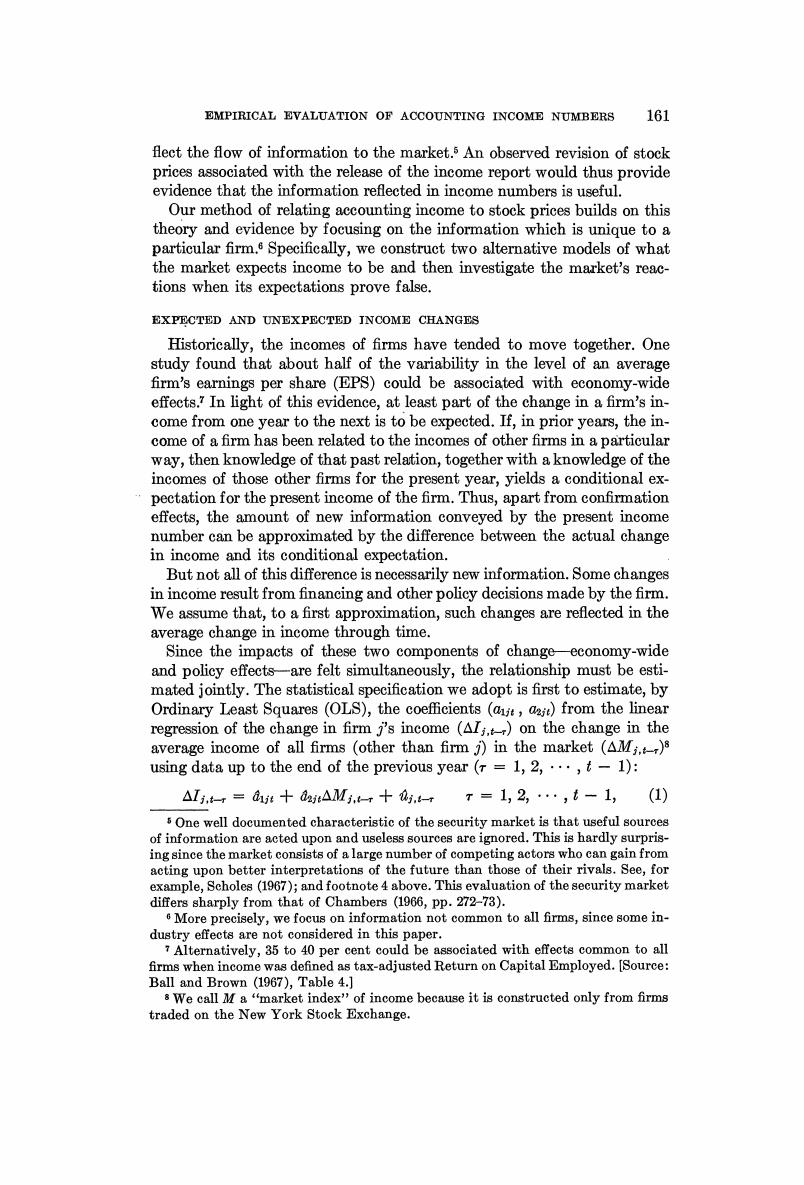正在加载图片...

EMPIRICAL EVALUATION OF ACCOUNTING INCOME NUMBERS 161 flect the flow of information to the market.5 An observed revision of stock prices associated with the release of the income report would thus provide evidence that the information reflected in income numbers is useful. Our method of relating accounting income to stock prices builds on this theory and evidence by focusing on the information which is unique to a particular firm.6 Specifically,we construct two alternative models of what the market expects income to be and then investigate the market's reac- tions when its expectations prove false. EXPECTED AND UNEXPECTED INCOME CHANGES Historically,the incomes of firms have tended to move together.One study found that about half of the variability in the level of an average firm's earnings per share (EPS)could be associated with economy-wide effects.7 In light of this evidence,at least part of the change in a firm's in- come from one year to the next is to be expected.If,in prior years,the in- come of a firm has been related to the incomes of other firms in a particular way,then knowledge of that past relation,together with a knowledge of the incomes of those other firms for the present year,yields a conditional ex- pectation for the present income of the firm.Thus,apart from confirmation effects,the amount of new information conveyed by the present income number can be approximated by the difference between the actual change in income and its conditional expectation. But not all of this difference is necessarily new information.Some changes in income result from financing and other policy decisions made by the firm. We assume that,to a first approximation,such changes are reflected in the average change in income through time. Since the impacts of these two components of change-economy-wide and policy effects-are felt simultaneously,the relationship must be esti- mated jointly.The statistical specification we adopt is first to estimate,by Ordinary Least Squares (OLS),the coefficients (ai,z)from the linear regression of the change in firm i's income(AIj.+)on the change in the average income of all firms (other than firm j)in the market (AMj.)8 using data up to the end of the previous year (r 1,2,...,-1): △Ii,tr=dit+dAMi,tr十ai,tr T=1,2,…,t-1, (1) s One well documented characteristic of the security market is that useful sources of information are acted upon and useless sources are ignored.This is hardly surpris- ing since the market consists of a large number of competing actors who can gain from acting upon better interpretations of the future than those of their rivals.See,for example,Scholes(1967);and footnote 4 above.This evaluation of the security market differs sharply from that of Chambers (1966,pp.272-73). e More precisely,we focus on information not common to all firms,since some in- dustry effects are not considered in this paper. 7Alternatively,35 to 40 per cent could be associated with effects common to all firms when income was defined as tax-adjusted Return on Capital Employed.[Source: Ball and Brown (1967),Table 4.] 8 We call M a "market index"of income because it is constructed only from firms traded on the New York Stock Exchange